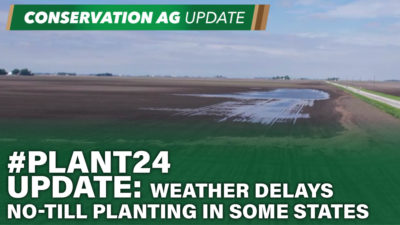Although some pests migrate to Pennsylvania in the spring, some overwinter as well. Below are descriptions of some of the insect pests in field crops that overwinter in Pennsylvania and that are easier to monitor or manage in the spring.
Alfalfa Weevil
The alfalfa weevil is an invasive insect, presumably from Asia, and is one of the most damaging insects in alfalfa fields. They usually overwinter as adults. In the spring, females chew holes into alfalfa stems to deposit eggs. Although alfalfa weevil is not economically damaging every year, scouting is the best method to monitor and manage populations.
Brown Marmorated Stink Bug
The Brown Marmorated Stink Bug (BMSB) is an invasive insect from Asia that was introduced to Pennsylvania in the 1990s. BMSB is a pest in many crops including fruits, vegetables, ornamentals, and field crops. BMSB can be a nuisance during the fall and early winter because they aggregate in buildings and homes to overwinter. Naturally, they overwinter in wood lots. BMSB tend to move into crop fields from wooded areas and hedgerows, but stay near the edges of fields. Scouting along wooded margins of fields is ideal to monitor populations.
Cereal Leaf Beetle
The cereal leaf beetle is native to Europe and Asia and is occasionally a severe pest of wheat, oats, and other grasses in Pennsylvania. Adults leave crop fields in the fall to overwinter in leaf litter in wooded areas and hedgerows. In the spring, adults fly back to grain fields to deposit eggs. Larvae hatch from the eggs, but it is the older larvae that cause the most damage by defoliating plants. Cereal leaf beetles are easier to manage in the spring when eggs or larvae are present.
European Corn Borer
European Corn Borer (ECB) was introduced to Massachusetts from Hungary and Italy in 1917. There are two strains of ECB that occur in Pennsylvania. Both strains overwinter as larvae and pupate in the spring. Adults emerge and deposit eggs in May to June. The newly hatched larvae bore into the main corn stalk where they complete their development. One strain goes into diapause and overwinters at this point, having one generation per year. The other strain has two or more generations per year, completing development and laying eggs in August.
Field corn losses are usually attributed to the strain that has multiple generations because the second-generation larvae feed on the tassel or enter the ear or shank, causing the stalks to break. Planting before May 20th can reduce damage caused by second generation ECB. Controlling weeds and using transgenic varieties can also help. Chemical control is not usually recommended.






Post a comment
Report Abusive Comment